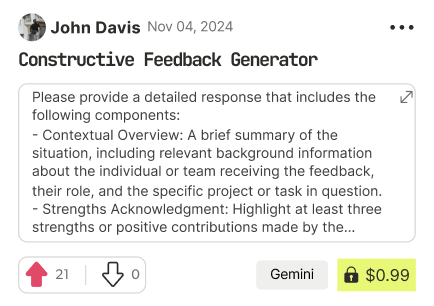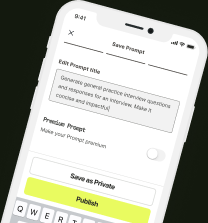prompt mine App
Find, Create & Share AI Magic
Upselling, Cross-selling, and Down-selling Strategies
It is great to focus on these sales techniques to maximize your customer value. Here are strategies and step-by-step instructions for upselling, cross-selling, and down-selling, applicable to any business or products by adapting the examples.
General Principle: Understand your customer's needs and pain points first. Every recommendation should genuinely add value.
Upselling Strategies and Steps
Strategy: Encourage customers to purchase a more expensive, premium, or upgraded version of the product they are already interested in or considering. The goal is to show them the added value for a slightly higher investment.
When to Implement: This is best done early in the sales process, once a customer has expressed interest in a base product but before they have fully committed to a purchase. It is also effective at the point of decision, like a shopping cart.
Steps for Upselling:
Step 1: Understand the customer's specific needs. Ask open-ended questions to learn what they hope to achieve with their purchase. For example, if they are looking at a basic laptop, ask what they will use it for most.
Step 2: Identify a premium alternative that directly addresses or exceeds their expressed needs. This should be a product that offers clear, tangible benefits over the initial item. For a basic laptop, suggest one with more memory or a faster processor if they mentioned gaming or video editing.
Step 3: Clearly articulate the EXTRA value and benefits of the upgraded product. Focus on how it solves more problems or provides a better experience. Do not just list features; explain what those features MEAN for the customer. Emphasize improved performance, durability, or included premium services.
Step 4: Offer a clear comparison. Show the price difference versus the value gain. Sometimes, a small extra cost leads to a significantly better outcome. Say something like, "For just X dollars more, you get Y benefits, which will save you Z time or provide A peace of mind."
Cross-selling Strategies and Steps
Strategy: Offer complementary products or services that enhance the value or utility of the main product a customer is purchasing or has just purchased. These are items that naturally go together.
When to Implement: The ideal time for cross-selling is immediately after a customer has committed to a main purchase or added an item to their cart. It can also be effective in follow-up communications or during installation.
Steps for Cross-selling:
Step 1: Identify logical complementary items. Think about what accessories, services, or related products naturally pair with the main purchase. If a customer buys a camera, think of lenses, tripods, or camera bags. If they buy software, think of training or extended support.
Step 2: Present the complementary items as solutions that complete the experience or protect their investment. Frame them as helpful additions, not just extra costs. You could say, "Many of our customers also find this item essential for getting the most out of their purchase."
Step 3: Explain the SYNERGY. How do the two items work better together than separately? For example, "This extended warranty will protect your new appliance," or "This cleaning kit will help maintain the shine on your new car."
Step 4: Make it convenient to add. Suggest it at checkout, or have a "frequently bought together" section online. Make the process of adding the extra item seamless.
Down-selling Strategies and Steps
Strategy: Offer a less expensive, simplified, or more basic version of a product or service when a customer expresses budget concerns, hesitates, or outright rejects a higher-priced initial offer. The goal is to salvage the sale and keep the customer engaged, even if at a lower price point.
When to Implement: This technique is crucial when a customer shows resistance to the price of the initial offer. It is a fallback strategy to prevent losing the sale entirely.
Steps for Down-selling:
Step 1: Listen carefully to the customer's concerns. Is it truly about price, or is it about perceived value for the cost? Acknowledge their budget constraints without judgment. For example, "I understand that price point might be a bit high."
Step 2: Present a viable, lower-cost alternative. This should be a product that still meets their core need but perhaps with fewer features, a smaller size, or a less premium material. For a high-end service package, offer a basic one with fewer inclusions.
Step 3: Focus on the CORE value that the down-sold product still provides. Highlight what the customer DOES get, not what they are missing. Emphasize that it still solves their primary problem or achieves their main goal. Say, "While it does not have X feature, it will still accomplish Y, which I know is important to you."
Step 4: Keep the door open for future upgrades. Even if they choose the cheaper option now, express that they can always upgrade later or add features. This builds goodwill and offers a path for future upselling. For example, "You can always upgrade to the premium version later if you find you need those extra features."
Upselling, Cross-selling, and Down-selling Strategies


Find Powerful AI Prompts
Discover, create, and customize prompts with different models, from ChatGPT to Gemini in seconds

Simple Yet Powerful
Start with an idea and use expert prompts to bring your vision to life!